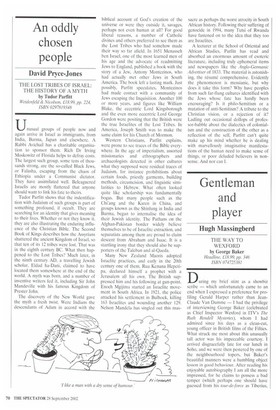An oddly chosen people
David Pryce-Jones
THE LOST TRIBES OF ISRAEL: THE HISTORY OF A MYTH by Tudor Parfitt Weidenfeld & Nicolson, £18.99, pp. 224, ISBN 0297819348 Unusual groups of people now and again arrive in Israel as immigrants, from India, Burma, Japan and elsewhere. A Rabbi Avichail has a charitable organisation to sponsor them. Rich Dr Irving Moskowitz of Florida helps to defray costs. The largest such group, some tens of thousands strong, are the so-called Black Jews, or Falasha, escaping from the chaos of Ethiopia under a Communist dictator. They have assimilated well. Beleaguered Israelis are mostly flattered that anyone should want to link his fate to theirs.
Tudor Parfitt shows that the indentification with Judaism of such groups is part of something profound, if occult, They are searching for an identity that gives meaning to their lives. Whether or not they know it, they are also illustrating the enduring influence of the Christian Bible. The Second Book of Kings describes how the Assyrians shattered the ancient Kingdom of Israel, so that ten of its 12 tribes were lost. That was in the eighth century BC. What then happened to the Lost Tribes? Much later, in the ninth century AD, a travelling Jewish scholar, Eldad ha-Dani, claimed to have located them somewhere at the end of the world. A myth was born, and a number of inventive writers fed it, including Sir John Mandeville with his famous Kingdom of Prester John.
The discovery of the New World gave the myth a fresh twist. Were Indians the descendants of Adam in accord with the
biblical account of God's creation of the universe or were they outside it, savages, perhaps not even human at all? For good liberal reasons, a number of Catholic divines and others preferred to see them as the Lost Tribes who had somehow made their way so far afield. In 1651 Menasseh ben Israel, one of the most learned men of his age and the advocate of readmitting Jews to England, published a book with the story of a Jew, Antony Montezinos, who had actually met other Jews in South America. The book left a lasting mark. Just possibly, Parfitt speculates, Montezinos had made contact with a community of Jews escaping the Inquisition. Another 100 or more years, and figures like William Blake, the eccentric Lord Kingsborough and the even more eccentric Lord George Gordon were positing that the British were the true Israelites of the Lost Tribes. In America, Joseph Smith was to make the same claim for his Church of Mormon.
Western Christians, Parfitt explains, were prone to see traces of the Bible everywhere. In the age of imperialism, assorted missionaries and ethnographers and archaeologists detected in other cultures what they supposed were residual traces of Judaism, for instance prohibitions about certain foods, priestly garments, building methods, circumcision, and linguistic similarities to Hebrew. What often looked quite like scholarship was fundamentally bogus. But many people such as the Chi'ang and the Karen in China, and groups known as the Shinlung in India and Burma, began to internalise the idea of their Jewish identity. The Pathans on the Afghan-Pakistan border widely believe themselves to be of Israelite extraction, and separatists among them arc proud to claim descent from Abraham and Isaac. It is a startling irony that they should also be supporters of the Taleban and al-Qaeda.
Many New Zealand Maoris adopted Israelite practices, and early in the 20th century one of them. Rua Kenana Hepetipa, declared himself a prophet with a Jerusalem all his own. The British suppressed him and his following at gun-point. Enoch Mgijima started an Israelite movement in South Africa. In 1921, the police attacked his settlement in Bulhoek, killing 163 Israelites and wounding another 129. Nelson Mandela has singled out this mas
sacre as perhaps the worst atrocity in South African history. Following their suffering of genocide in 1994, many Tutsi of Rwanda have fastened on to the idea that they too are Israelites.
A lecturer at the School of Oriental and African Studies, Parfitt has read and absorbed an enormous amount of esoteric literature, including truly ephemeral items and newspapers like the Anglo-Germanic Advertiser of 1833. The material is astonishing, the résumé comprehensive. Evidently the phenomenon is messianic, but why does it take this form? Why have peoples from such far-flung cultures identified with the Jews whose fate has hardly been encouraging? Is it philo-Semitism or a mutation of anti-Semitism? A tribute to the Christian vision, or a rejection of it? Ladling out occasional dollops of professor-babble about the dialectics of colonialism and the construction of the other as a reflection of the self, Parfitt can't quite make up his mind whether he is dealing with marvellously imaginative manifestations of the human need to make sense of things, or poor deluded believers in nonsense. And nor can I.


































































































 Previous page
Previous page